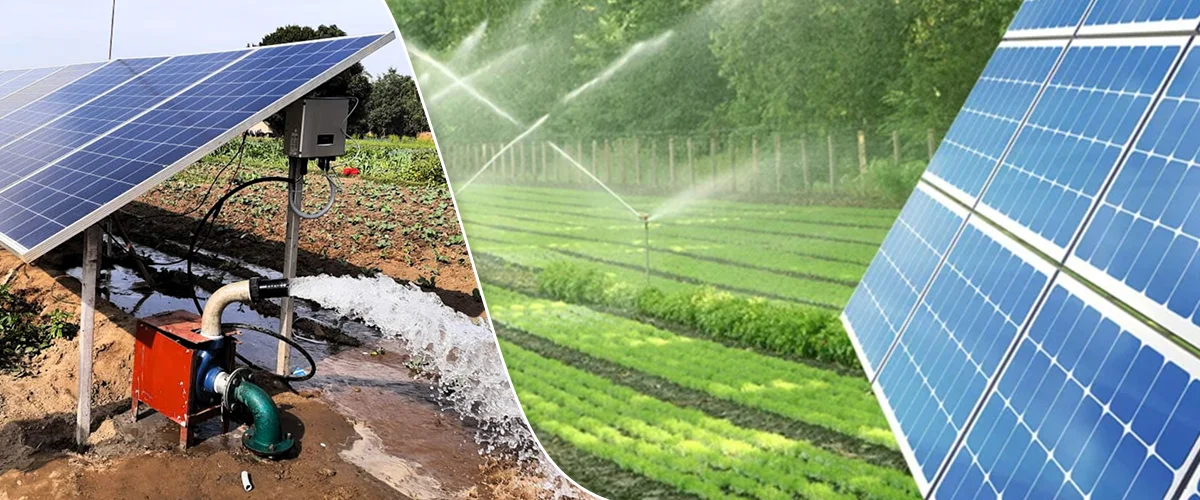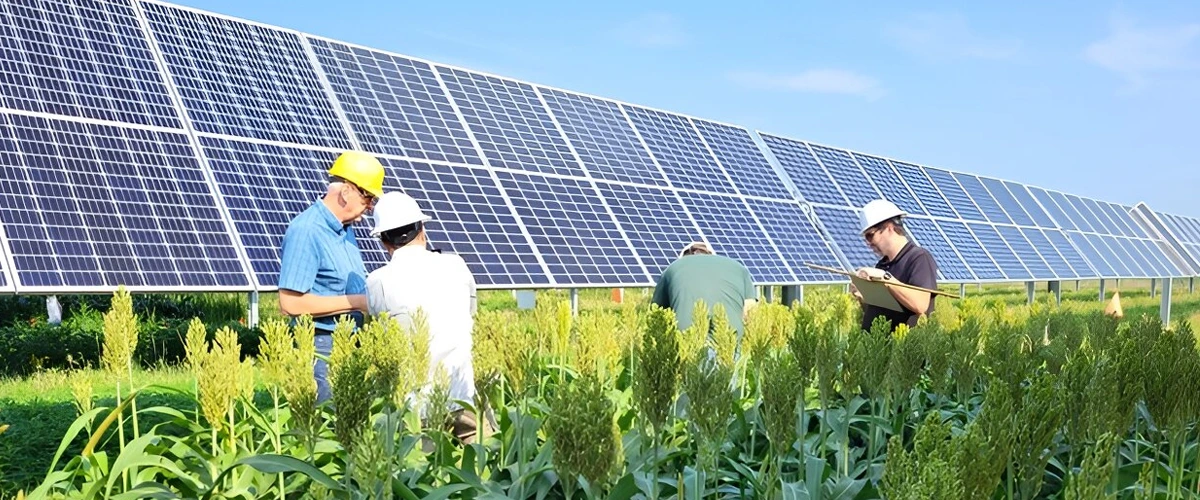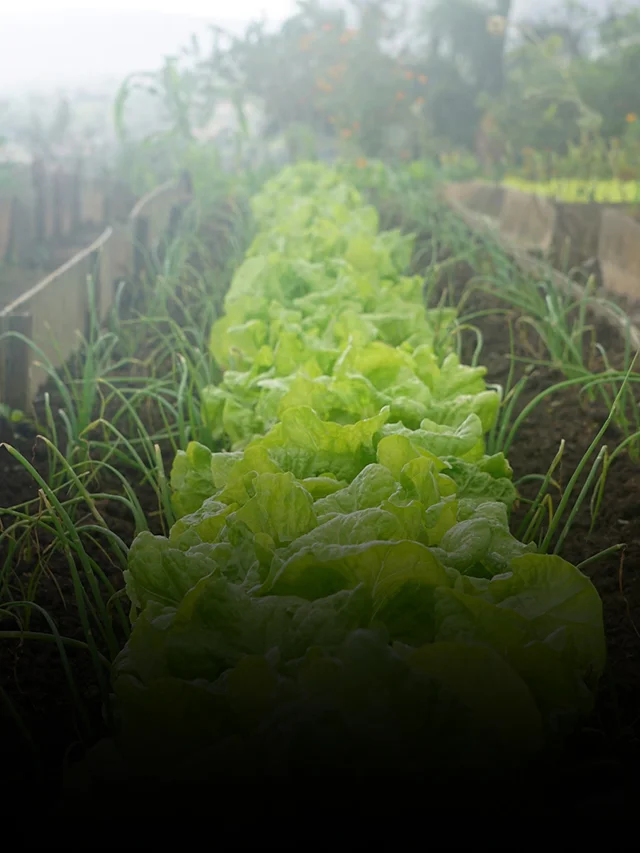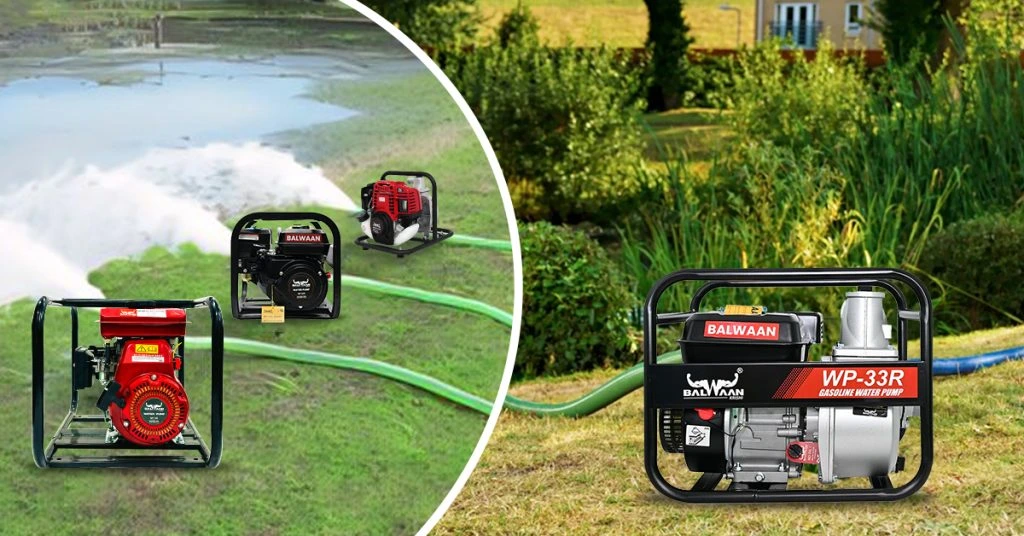
Solar Farming has changed the lives of many people including Indian farmers by generating an extra source of income and reducing their dependence on unpredictable weather patterns, insufficient water supply, and expensive electricity.
Farmers get an opportunity to earn a consistent income by letting their land on lease for solar farming projects by placing solar panels on their land or selling out excess electricity back to the grid.
This extra source of income has improved their financial stability and resilience.
Moreover, solar irrigation systems powered by these solar farms have improved agriculture practices, and water availability for crops, and have increased agricultural production even in areas with water scarcity.
Overall, solar farming in India has not only empowered Indian farmers economically but also equipped them with sustainable and eco-friendly solutions, significantly improving their quality of life.
For efficient and affordable solar irrigation, Balwaan Krishi presents India’s No.1 water pump that not only gives you outstanding results, and saves you money but also runs longer than any water pump.
Benefits of Solar Farming
Clean Energy: Solar farming generates electricity without emissions, reducing air pollution and contributing to a healthier environment by using the abundant power of the sun.
Reduced Bills: Solar panels on farms lower electricity bills, freeing up resources for other farming needs and benefiting rural communities by lowering overall energy costs.
Income Generation: Farmers can lease their land for solar farming projects, creating a reliable source of income, and enhancing their financial stability.
Water Efficiency: Solar-powered irrigation systems efficiently use water resources, conserving this precious resource while boosting crop yields and ensuring agricultural sustainability.
Energy Independence: By producing electricity, farmers reduce dependence on fossil fuels and minimize the impact of fluctuating fuel prices, enhancing energy security.
Environmental Benefits: Solar farming reduces carbon emissions, helping combat climate change and preserving natural ecosystems, making it an environmentally friendly energy solution.
Distributed Energy: Small-scale solar farms bring energy solutions to remote areas, improving energy access and reducing dependency on centralized power sources.
Technological Innovation: The solar Farming Industry drives innovation, leading to more efficient solar panels and advanced energy storage technologies, which benefit both farms and the broader energy sector.
Solar Farming Setup Guide
Choose the Right Location: Select an area with sufficient sunlight, as solar panels work best in direct sunlight with minimal shading to maximize energy production.
Selection of Solar Panels: Invest in high-quality solar panels with a good warranty, as they are a long-term investment. Monocrystalline panels are known for their efficiency and durability.
Inverter Installation: Inverters are crucial, they convert the electricity generated by solar panels (DC) into usable household electricity (AC) and should be installed by a certified electrician.
Mounting the Panels: Proper panel positioning is essential. Ensure they face the sun’s direction (south in the Northern Hemisphere, north in the Southern Hemisphere) to capture the most sunlight throughout the day.
Wiring and Connection: Panels must be wired correctly in series or parallel to create an efficient solar array. Consult with a professional electrician for proper wiring and connections to the inverter.
Battery Backup: Adding batteries can store excess energy for nighttime use or emergencies, enhancing your energy independence.
Grid Connection: Connecting to the grid allows you to sell excess energy back to your energy provider company or take power when Your solar farm isn’t producing enough electricity.
Regular Maintenance: Regularly clean panels with water and a soft brush to remove dirt and debris. Inspect the system for loose connections and signs of damage.
Monitoring: Use a monitoring system to keep track of energy production, helping you identify issues early, optimize performance, and maximize your savings.
Safety Precautions: Follow safety guidelines and electrical codes, especially when working near electrical components. Disconnect the system during maintenance to prevent accidents.
Enjoy Cost Savings: As your solar farm produces electricity, Enjoy your electricity bills decrease, providing long-term cost savings and a return on your investment.

How to Maintain a Solar Farm?
Keep Panels Clean: Regularly rinsing solar panels with water removes dirt and dust, ensuring they capture sunlight effectively and generate maximum electricity.
Check for Damage: Inspect panels for cracks or any visible damage; fixing these issues immediately helps maintain panel efficiency and prolong their lifespan.
Secure Wires: Ensure all wires are tightly connected to prevent energy loss and electrical hazards that could arise from loose connections.
Trim Trees: Trim branches and bushes that create shadows on panels to ensure they receive the necessary sunlight for optimal performance.
Watch Inverters: Regularly check inverters for signs of overheating or damage, as they are crucial components for converting sunlight into usable electricity.
Monitor Performance: Install a monitoring system to keep an eye on your solar farm’s performance, making it easier to detect and address issues.
Battery Care: If you use batteries to store excess energy, inspect them for problems and ensure they function correctly to provide backup power when needed.
Stay Safe: Always follow guidelines when handling electrical components, and seek professional help when in doubt about maintenance or repairs.
Prepare for Storms: Secure panels and equipment for severe weather to prevent damage during storms or strong winds.
Read Manuals: Keep your system’s manual handy; it serves as a valuable resource for troubleshooting and addressing maintenance issues.
Keep Birds Away: Prevent birds from nesting behind panels, which can cause messes and block sunlight.
Keep Records: Maintain a record of your maintenance activities to track what you’ve done and when which can help you detect issues or future problems.
Conclusion
Solar farming profit has gradually increased in today’s time because of its multiple advantages, ranging from sustainable energy generation to financial benefits. To maximize these benefits, it is essential to invest in high-quality agricultural equipment. For that, you can read our latest blog Top 15 Best Affordable Agricultural Machinery in India to buy the best high-quality equipment for your farming.
Balwaan Krishi provides an excellent solution with its affordable, innovative, and ISI-certified farming equipment. By choosing Balwaan Krishi, you can not only save money and increase production on your solar farm but can also contribute to a more sustainable future for our planet.
Adopting solar farming in agriculture and using reliable equipment like Balwaan Krishi’s is a step towards a greener and more profitable agricultural environment, benefiting both farmers and the environment. Make the smart choice for your solar farm’s success and the Earth’s sustainability – choose Balwaan Krishi.
Mostly Asked Questions
1. How much does a solar farm cost in India?
In India, the cost of a solar farm per acre varies. The average cost per acre ranges between ₹10 lakh and ₹40 lakh. The price is determined by factors such as location, solar panel type, and solar farm size. Setting up a solar farm in India can cost up to 5 lakh per acre.
2. How profitable is a solar farm?
A solar farm can be very profitable, with returns coming from energy savings, selling electricity to the grid, and leasing land for solar projects. Profitability is determined by factors such as location, investment costs, and government incentives, but many solar farms generate consistent long-term revenue.
3. What’s a reasonable price for solar installation in India?
Solar installations in India typically cost between ₹75,000 and ₹85,000 per kilowatt (kW), depending on panel quality, installation size, and location. Larger installations may have lower per-kW costs due to economies of scale.
























